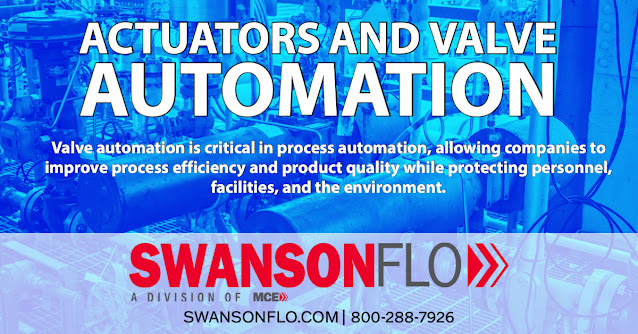
The Swanson Flo Blog is dedicated to provide educational and new product information on process control instrumentation, control valves, and valve automation. For more information on these products, visit SwansonFlo.com or call 800-288-7926.
Actuators and Valve Automation
StoneL Valve Communications for Food and Beverage
Reliable Solutions for Networking and Control System Integration
Meeting increasing demand while maintaining safety is a critical factor in the food and beverage industry. This pressure is driving technologies that help meet regulatory requirements while delivering a competitive edge in efficient and economic performance. Proven technologies and enhanced capabilities are helping overcome new challenges.
Food and beverage companies are facing increasing competition and need increased efficiency, reduced costs, and agility. StoneL is working with many global industry leaders to address these needs and requirements with StoneL valve controllers and monitors. A comprehensive service offering and service network support all StoneL products.
Monitoring Precision
The Axiom and Prism platforms use continuous solid-state sensors that have increased reliability and precise position measurement compared to mechanical or proximity-reed technology. These sensors enable more sophisticated valve diagnostics, leading to reduced life cycle maintenance costs.
Compact Size
The Axiom, Prism, and Eclipse products are all rich with features designed to meet the industry’s increasing need for smaller, lighter, and more durable products to conform to modular process skids and flexible manufacturing requirements. For example, the integral solenoid of the Axiom allows for a smaller overall envelope size on the skid, thanks to less connected tubing and cabling needed to complete the valve assembly.
Predictive Maintenance
You can avoid downtime due to valve failure by having easy access to information about critical parameters. Using WirelessLink, you can remotely monitor valve function, including travel position, time to open/close, and cycle count of your valve. This data can help maintenance quickly identify and address a problem before it causes danger or downtime, at the same time allowing you to extend the life of critical valves.
Improving Safety with Wireless Link
The Wireless Link can help you access difficult-to-reach communication and control modules safely and conveniently. Using StoneL secure app on your iOS mobile device may help you achieve further cost savings while keeping you at a safe distance, up to 50 meters away. With access to cycle count data, you can perform valve maintenance when needed and replace parts before wearing out. You can finally forget scheduling maintenance based on calendar days instead of service needs.
Valve automation and networked valve control devices improve the quality and availability of diagnostics data. At the same time, they help reduce maintenance costs and safety risks at your plant.
StoneL FieldLink products and services enable automated valves and instruments to interconnect with your plant’s control system using standardized, proven, field-based communication protocols.
StoneL offers a full array of components to cost-effectively and reliably complete the valve communication network. That includes power supplies, control system interfacing gateways/masters, robust protected drop connector systems, and connectivity accessories.
DOWNLOAD THE STONEL FOOD AND BEVERAGE BROCHURE HERE
Swanson Flo
https://swansonflo.com
800-288-7926
Swanson Flo - An Industry Leader in Process Automation with a Long History of Unmatched Project Success
Founded in 1960, Swanson Flo has long maintained our position as an industry leader in process automation with unmatched project success leveraging industry preferred products and services.
Our team of skilled experts is uniquely equipped to rapidly apply resources and skills for the maximum benefit of our clients. We continue to adapt new technologies and solutions to build solid client partnerships.
Our mission is to provide innovative process control solutions for engineers, managers and maintenance professionals through quality equipment and experienced application engineering. These efforts combined with excellent aftermarket service yield reduced operating costs and improved production.
1960 Thomas B Swanson Co.
Tom B. Swanson saw a need for innovative technical products for industrial applications that was being underserved by the large PVF wholesale houses. Tom started a rep company focusing on new specialty and engineered products.
1974 Swanson Flo-Systems Co.
Tom Swanson and his business partner, Dick Westphal, saw that industrial processes were changing from manual operation to automated systems and solutions to improve quality and gain efficiencies. This forward thinking and vision inspired a new business model of actuation and fabrication to service their customers’ needs, providing automated solutions, while providing a high degree of technical support and customer focus.
1989 Evolution of Swanson Flo Systems
Expands our integration of products by adding control valves and specialty valves to their quality, technical product offering.
1991 Tom Howe acquired Thomas B Swanson equity.
Tom Howe and Dick Westphal continue to serve their customers with a vision to provide full control loop solutions and application engineering experience to the growing market by integrating our products to help customers develop more efficient, productive, and profitable process solutions.
1992 - Acquired Control Dynamics, Co.
The acquisition of Control Dynamics Co. added experienced personnel and additional instrumentation lines including Foxboro and Badger Meter Co. This addition allowed Swanson to provide experienced, technical personnel to assist in the evaluation, specification and application of valves and instrumentation for projects and customer needs.
2001 – Acquired Power Supply and Engineering Co.
Swanson Flo acquires PSE adding Ashcroft instrumentation and additional technical salespeople.
2001 – Acquired Limitorque Actuation Line
Swanson Flo continues their commitment to customers by adding an expanded automation offering with Limitorque. This acquisition created a shift to incorporating services to our product portfolio. Additional square footage was added to handle the services requirement. Expanding in-house repair and field service, and remanufacture electric actuators across the Dakotas, Wyoming, Montana, Minnesota, and Western Wisconsin.
2002 - Acquired Process Sales Inc., Wisconsin
Swanson Flo expands eastward into Wisconsin. Adding Masoneilan Control Valves and Foxboro Instrumentation to the entire state.
2005 - Launched BioFuels Automation Co.
BioFuels Automation becomes a wholly owned subsidiary of Swanson Flo launching the first exclusive renewable fuels focused automation company to serve this rapidly growing industry. Providing a complete solution for automating newly constructed ethanol plants for the future.
2007 - Acquired Failsafe Company
Swanson Flo expands into more quality technical products and experienced people for Wisconsin and Upper Michigan.
2013 - Acquired Valves and Automation Inc.
Swanson Flo adds Limitorque Electric Actuation across Wisconsin, Illinois, Iowa and Indiana, with an expansive shop to repair, assemble and remanufacture electric actuators.
2014 - Acquired Process Sales Inc.
Swanson Flo expands with Masoneilan Control Valves and Foxboro Instrumentation across Upper Illinois and Indiana with full control valve service, repair, and assembly facility.
2016 - Acquired Tech Sales and Marketing - Indiana
Swanson Flo grows in Indiana with additional lines and technical salespeople focused on quality products and customer service.
2021 – Swanson Flo is acquired by MCE to continue to service our customers with an extended offering of highly-engineered, technical solutions by providing leading process control products and services.
Removal and Installation of the Feedback Mechanism of the Flowserve Logix 3800 Positioner
This video demonstrates the removal and installation of the feedback mechanism of the Flowserve Logix 3800 valve positioner.
Make sure the valve is bypassed or in a safe condition. Disconnect power to the positioner. Disconnect air supply to the positioner. Remove the take off arm and follower arm.
Note, it is recommended that when the positioner is removed from the valve, it is taken to a clean work environment for disassembly and reassembly.
Note, the procedure is the same for both intrinsically safe, or explosion-proof, positioners.
Begin by removing the three screws that attach the feedback assembly to the positioner housing. Install the replacement feedback assembly to the positioner housing.
Note, the orientation is irrelevant since the feedback mechanism has a clutch. Torque the screws to 0.9 Newton meters or 8 inch pounds. Next reconnect the positioner follow arm and take off arm to the valve.
For more information, contact Swanson Flo. Visit their web site at https://swansonflo.com, or call them at 800-288-7926.
Swanson Flo Has You Covered
Founded in 1960, Swanson Flo has long maintained our position as an industry leader in process automation with unmatched project success leveraging industry preferred products and services. Our mission is to provide innovative process control solutions for engineers, managers and maintenance professionals through quality equipment and experienced application engineering.
Swanson Flo
https://swansonflo.com
800-288-7926
Full Service Valve Automation
From simple pneumatically or electrically actuated valves, to fully automated critical valve systems, Swanson Flo delivers tested, certified, and extremely reliable product every time. Actuated valve assemblies precisely engineered for the best fit, highest performance, and optimal life.
With decades of combined experience and knowledge, Swanson Flo technicians match state-of-art components with best-in-class manufacturers and deliver carefully crafted valve packages.
Swanson Flo customers always receive the highest quality and best value possible. Their strong reputation was built upon:
- The largest, most comprehensive facility in the Midwest.
- In-house capabilities for all electric, pneumatic and electro-hydraulic actuators.
- Experienced design engineering and fabrication.
- Support for assembly of all valve, actuator, monitor and positioner technologies.
- Complete solution for testing and serialization.
Limitorque Pneumatic Compact Scotch Yoke Actuator Model LPC
LPC compact actuators deliver up to 5500 Nm (4057 ft-lb) of precisely controlled torque. The LPC product range is complementary to the Limitorque LPS heavy-duty pneumatic Scotch yoke actuators.
A similar design philosophy to the heavy-duty LPS was applied to the new LPC range, delivering enhanced performance and high reliability. The LPC is available in standard as well as special material configurations upon request.
For more information, review the embedded document below, or you can download a PDF version of "Limitorque Model LPC Pneumatic Compact Scotch Yoke Actuator" here.
Valve Actuation 101: The Three Basic Types of Pneumatic Valve Actuator
- Scotch-yoke
- Rack & pinion
- Rotary vane
All three styles are available in either direct acting or spring return versions. Direct acting actuators use the air supply to move the actuator in both directions (open and close). Spring return actuators, as the name implies, uses springs to move the actuator back to its "resting" state. Converting from direct acting to spring return is done through simple modifications, typically just adding an external spring module, or removing the end caps from rack and pinion actuators and installing several coil springs.
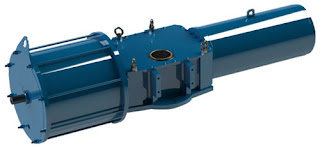 |
| Scotch yoke (Limitorque) |
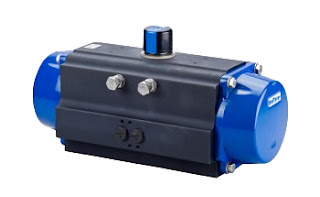 |
| Rack and pinion (Delval) |
Vane actuators generally provide the most space savings when comparing size-to-torque with rack and pinion and scotch yoke. They have a reputation for long life because then contain fewer moving parts than rack and pinion and scotch yoke actuators. Vane actuators use externally mounted, helically wound "clock springs" for their spring return mechanism.
Swanson Flo Markets - New Video
Valve Automation Basics: Electric Actuators
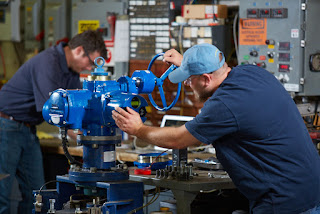 |
| Electric Actuator Assembly (Limitorque) |
There are other motive forces used for valve actuators, including hydraulic and pneumatic, but electric actuators carry their own particular set of operating characteristics that make them an advantageous choice for many applications.
Valve actuators are available in uncountable variants to suit every application scenario. There are three basic valve actuation motions.
- Multi-turn, with repeated rotations of the valve shaft needed to move the valve trim from fully open to fully closed. A gate valve is a multi-turn valve. These are also called linear, with respect to the motion of the closure element. The term "linear", in this case, refers only to the movement of the valve trim and not the flow characteristics of the valve.
- Part Turn, where a 90 degree rotation of the valve shaft produces a change from opened to closed. Ball valves are in this category.
- Lever, generally associated with damper control.
 |
| Completed Electrically Automated Valve |
There are numerous considerations to take into account when selecting an electric actuator.
- Torque needed to effectively operate the subject valve.
- Actuator enclosure type - wash down, hazardous area, dust, etc.
- Service area for the assembly - corrosive environment, temperature extremes, and more
- Valve movement - linear, multi-turn, part turn, lever
- Operation mode - open and close only, positioning, modulating
- Frequency or duty cycle - infrequent, frequent, or almost continuous positioning
- Communication - How will the local controller communicate with the central control system?
- Electrical - What electric power characteristics are available for operation?
- Protections - Motor overload, torque limit, others
- Process Safety - Among other things, what happens if power fails?
There are certainly other elements to consider when applying an electric actuator for industrial use. Share your valve and actuator requirements and challenges with product specialists, combining your process knowledge with their product application expertise to forge the most effective solutions.
https://swansonflo.com
800-288-7926
Swanson Flo Performance - Full Capability Instrumentation and Valve Service & Repair
In-house repair as well as field service capabilities for process measurement and control.
Swanson Flo Performance supports every process control customer with region-based, full-capability service and repair. Both in-house and in-field. Built on more than 50 years of applications experience and technical knowledge.- From valves and instruments to actuation, fabrication and preventative maintenance.
- Our technicians are factory-certified.
- Shop is factory audited.
- Total service for process measurement and control
- Valve actuation facilities – the "Center of Excellence"
- Instrument calibration, repair, and trouble-shooting services
Limitorque MX Actuator Users Instructions, Maintenance, and Spare Parts Manual
No battery or backup power supply is required. Output torque is derived from motor speed, temperature, and voltage. If the preset torque is exceeded, the motor shuts off. As a result of this reliable and advanced protection technology, all valve and other actuated devices are protected from potential damage from overload, improper seating, and foreign obstructions.
A range of control and network options is available and can be easily added to the control capabilities already available on a standard actuator.
You can download the Limitorque MX Electronic Actuator User Instructions, Maintenance, and Spare Parts Manual in PDF version from the Swanson Flo site here (8.5MB), or read the embedded version below.
Limitorque Actuator Product Range
- Intrusive Multi-Turn Actuators - L120 and SMB Series
- Non-Intrusive Multi-Turn Actuators - MX Series
- Non-Intrusive Quarter-Turn Electric Actuators - QX Series
- Gas Powered Actuators - LDG Direct Gas Actuator
- Hydraulic Actuators - LHS and LHH Series
- Pneumatic Actuators - LPS and LPC Series
- Multi-Turn Gearboxes - V Series and SR Series
- Quarter-Turn Gearboxes - WG Series and HBC Series
Understanding Industrial Rack and Pinion Valve Actuators
 |
| Basic concept of rack and pinion gear. |
Pneumatic rack and pinion actuators utilize air pressure as the motive force which changes the position of a valve. A rack and pinion actuator is comprised of two opposing pistons, each with its own gear (referred to as the "rack"). The two piston racks are set against a round pinion gear. As pressure increases against one side of each piston, each rack moves linearly against the opposite sides of the pinion gear causing rotational movement. This rotational movement is used to open and close a valve. See the animation above (provided by Wikipedia) below for a visual understanding.
This short video introduces the basic parts and operation of rack and pinion valve actuators to anyone unfamiliar with the device.
Visit http://www.swansonflo.com to learn more about industrial valves, valve actuators, and valve automation.
Swanson Flo Performance
- Valve automation center
- Experienced staff of factory-certified technicians
- Responsive on-call repair and service
- Extensive OEM parts inventory
- Third party audited standards
- The region’s widest range of industry application experience
- Comprehensive multi-brand process equipment knowledge
Flowserve Valtek Valve Automation
Swanson Flo is a premier valve and valve automation supplier located in Plymouth, MN with warehouse and fabrication facilities in Addison, IL, Indianapolis, IN and Menomonee Falls, WI.
Visit Swanson Flo at http://www.swansonflo.com or call 800-288-7926 with any valve automation project.
Swanson Flo Valve Automation Services
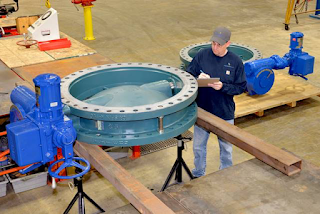 |
| 42 inch electrically (Limitorque) actuated butterfly valve. |
From simple, small pneumatic or electrically actuated valves, to very large, critical-control valve systems, Swanson Flo delivers tested, certified, and reliable product to customers located in the Upper Mid-West. Swanson Flo designs, engineers, and assembles actuated valve assemblies for the best fit, highest performance, and optimal application life. Their engineers and technicians combine decades of experience and knowledge. Coupled with a broad variety of carefully selected, readily available components, Swanson Flo customers are provided the best quality and best value possible.
Building upon 50+ years of industry and applications experience, Swanson Flo boasts the largest, most comprehensive automation facility in the mid-west, with capabilities for electric, pneumatic and electro-hydraulic actuation. A team of experienced design engineers and fabrication technicians construct automated valve systems from virtually any valve, actuator, monitor or positioner technology.
Swanson Flo Performance Brochure
Understanding Motor Operated Valves (MOV) in Industry
The MOV / electric actuator consists of an electric motor with the gearbox assembly which rotates the shaft of the valve. Most MOVs operate at 120, 240 or 480 volt, single or three phase. Basic features include adjustable limit switches to limit valve travel and to notify valve status, directional settings, analog inputs to allow for precise control, analog outputs to provide a feedback signal and digital communications. MOV enclosures can be either NEMA 4, NEMA 4X and NEMA 7 and are available in a wide range of torque outputs to match the valve it is operating.
Virtual Tour of Swanson Flo Illinois
The video below provides a virtual tour of our new Addison, Illinois warehouse, instrument calibration lab, and valve automation center.
For more information, visit Swanson Flo at http://www.swansonflo.com or call 800-288-7926.
